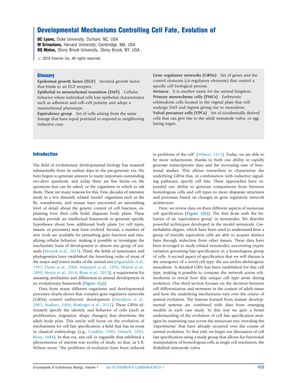Developmental Mechanisms Controlling Cell Fate Evolution
January 2016
in “
Elsevier eBooks
”

TLDR The conclusion is that grasping how cells determine their roles through evolution is key, with expected progress from new research models and genome editing.
The document reviews the evolution of cell fate specification mechanisms in metazoans, particularly focusing on gene regulatory networks (GRNs) in embryonic development and adult body plans. It examines the specification of vulval precursor cells in nematodes, highlighting the role of conserved and species-specific signaling pathways, and the evolution of the larval skeleton in echinoderms, noting the importance of the VEGF signaling pathway. The document also compares stem cells in adult mammals, like those in bone marrow and hair follicles, to pluripotent stem cells in planarians, and suggests that arthropod and vertebrate muscles may regenerate using similar lineage-restricted stem cells. It concludes that understanding cell fate specification in an evolutionary context is crucial and anticipates significant advances in the field due to new model systems and genome engineering techniques.
